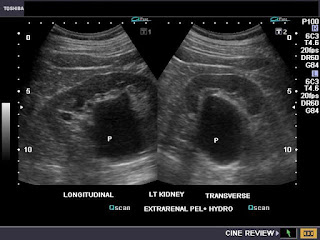Among the causes of infertility in women are diseases of the uterus and ovaries:
This middle aged lady has a very small uterus (called hypoplasia of the uterus). Such a uterus is incompatible with the ability to conceive and have a child. The ultrasound video clip below shows a sagittal (midline) section through the uterus. It was obtained via the transvaginal route. The vagina itself was sufficiently large enough to insert the transvaginal probe.
This prostate was visualized via the transrectal route. The color Doppler mode shows massively increased blood flow in the prostate (hyperemia), a hall mark of prostatitis. This condition of the prostate can be corrected to a large extent using medical treatment.
The above still color Doppler image shows the TRUS (transrectal ultrasound) view of the same prostate.
This middle aged lady has a very small uterus (called hypoplasia of the uterus). Such a uterus is incompatible with the ability to conceive and have a child. The ultrasound video clip below shows a sagittal (midline) section through the uterus. It was obtained via the transvaginal route. The vagina itself was sufficiently large enough to insert the transvaginal probe.
The inner lining of the uterine cavity- the endometrium appears markedly thinned, and again this is incompatible with conceiving a child.
The ultrasound video clip below is a transverse section through the uterus of the same patient:
For more on this case study visit: http://www.ultrasound-images.com/uterus.htm#Hypoplastic_uterus
In men, similarly, absence of or hypoplasia (very small) of parts of the reproductive system can result in infertility:
This male patient underwent sonography of the prostate and seminal vesicles via the transrectal route:
Ultrasound video clip shows normal sized prostate-
Observe the TRUS video clip as we pan the probe from the upper most part of the prostate showing the clear absence of the seminal vesicles and the vas deferens (agenesis) on both sides. This type of congenital absence of an important part of the route through which sperms pass from the testes to the penile urethra will result in total absence of spermatozoa in the ejaculated semen. This condition is called a azoospermia in the male.
Other and more common causes of infertility in men-
Perhaps one of the commonest cause of male infertility is a condition called varicocele.
Here, there is a dilatation of the veins around the testes, inside the scrotum. These veins are called the Pampiniform veins, and are responsible for draining blood from the testes. Due to decreased efficiency of the draining process, these veins swell and blood collects within these vessels resulting in increased temperature within the scrotum and the testes. The testes then lose some of their spermatogenic (sperm producing) functions. Depending on the degree of varicocele (grade of varicocele), the man may suffer from infertility.
Color Doppler Ultrasound can help in diagnosing this condition; see this link for more on this topic:
Diseases of the testes and the epididymis (a small structure next to the testis) can cause poor or impaired production of sperms. This can result in infertility. One such common condition is an inflammatory disease called orchitis and epididymo-orchitis. (see: http://www.ultrasound-images.com/scrotum.htm#Epididymitis
Another cause of impaired spermatogenesis (sperm formation) is chronic or past infection of the testes resulting in atrophy (shrinking) of the testes. This happens in mumps inflammation of the testes, a condition called mumps orchitis. See : http://www.ultrasound-images.com/scrotum.htm#Atrophy_of_testis
This condition causes decreased function of the testes with small shrunken testes. Atrophy of the testes is usually irreversible.
Another condition that involves another part of the male reproductive system is prostatitis or inflammation of the prostate. The prostate helps to form a bulk of the fluid in the semen. Inflammation of the prostate is common and can impair the production of semen and its release during ejaculation. This color Doppler video clip shows a severely inflamed prostate:
This prostate was visualized via the transrectal route. The color Doppler mode shows massively increased blood flow in the prostate (hyperemia), a hall mark of prostatitis. This condition of the prostate can be corrected to a large extent using medical treatment.
The above still color Doppler image shows the TRUS (transrectal ultrasound) view of the same prostate.




















































